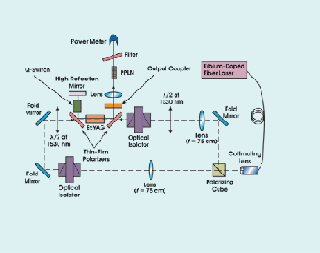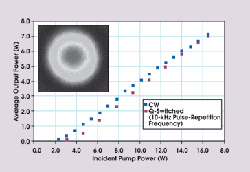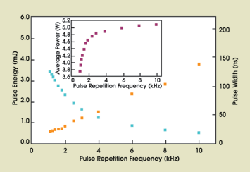Breck Hitz
Eye-safe lasers with output in the 1.5-µm regime are in demand for rangefinding, lidar and other remote-sensing applications. Most of them have depended on awkward nonlinear optics or on complex cross-excitation pumping schemes to generate 1.5-µm light, but researchers at BAE Systems in Nashua, N.H., have developed a resonantly pumped Er:YAG laser that generates 7 W of eye-safe radiation at 1.64 µm. They believe that this is the highest average power achieved from a bulk, Q-switched erbium laser. The advantage of bulk lasers over fiber lasers is their ability to produce the high-energy, Q-switched pulses required for most remote-sensing applications.
The scientists resonantly pumped the Er:YAG laser with a 21-W, high-brightness erbium-doped fiber laser at 1532 nm. In resonant pumping, both the optical pumping and the lasing transition take place between the same two atomic-energy-level manifolds. In the case of this Er:YAG laser, pump radiation excited the erbium ions from a low-lying Stark level of the ground 4I15/2 state to the 4I13/2 state, while the lasing transition was from the 4I13/2 state to a higher-lying Stark level of the 4I15/2 state. A major advantage of resonant pumping is the small quantum defect (i.e., the energy difference between the pump and the upper laser level) and a corresponding lower heating of the host material.

Figure 1. The U-shaped Er:YAG resonator was pumped from two directions by the output of an erbium-doped fiber laser. Thin-film polarizers coupled the pump light into the Er:YAG rod.
They split the pump power from the fiber laser into two orthogonally polarized beams with a polarizing cube and coupled each beam into the Er:YAG laser rod through thin-film polarizers (Figure 1). The polarizers facilitated separating the 1532-nm pump light from the 1645-nm laser light, and pumping the rod from both ends enhanced the uniformity of pump deposition over its length. Of the 21 W produced by the pump laser, slightly less than 17 W reached the Er:YAG rod. A high-reflector at one end and an output coupler at the other defined the U-shaped resonator. Between the mirrors were a quartz acousto-optic Q-switch, the Er:YAG rod and the two polarizers.

Figure 2. The average output from the laser exceeded 7 W, which the researchers believe is the highest ever reported from a bulk Er:YAG laser. The inset is the intensity profile of the beam, whose M2 was ~1.1.
The laser generated in excess of 7 W when Q-switched at 10 kHz and when running continuously, with a beam quality of ~1.1 (Figure 2). Because pulse energy is a critical parameter for remote-sensing lasers, the researchers varied the output coupler's transmission and reduced the pulse repetition frequency to allow more time for energy buildup in the upper laser level. At approximately 1.1 kHz, the laser yielded energies of 3.4 mJ in 21-ns pulses, which corresponds to a peak power of 162 kW (Figure 3). Operation at lower repetition frequencies and higher pulse energies was limited by damage to the thin-film polarizers.

Figure 3. The Er:YAG laser produced 3.4 mJ in 21-ns pulses, corresponding to a peak power of 162 kW.
The inset of Figure 3 shows that the average power diminished at frequencies below 2 kHz (i.e., periods greater than 500 µs). The scientists interpreted this as an indication that up-conversion reduces the energy-storage lifetime of the upper laser level to 500 µs. The normal fluorescence lifetime is 5 ms.
They also frequency-doubled the laser with an external crystal of periodically poled lithium niobate. To maximize the infrared peak power and, hence, the second-harmonic conversion efficiency, they chose a different Er:YAG rod and again adjusted the transmission of the output coupler.
These alterations produced no change in the laser's M2 and reduced the average power only to 6.7 W. They calculated an intracrystal harmonic power of 3.8 W at 822.5 nm, corresponding to a conversion efficiency of 69 percent.